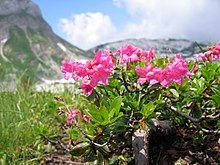
Rhododendron is a very large genus of about 1,024 species of woody plants in the heath family (Ericaceae). They can be either evergreen or deciduous. Most species are native to eastern Asia and the Himalayan region, but smaller numbers occur elsewhere in Asia, and in North America, Europe and Australia.

Laurel forest, also called laurisilva or laurissilva, is a type of subtropical forest found in areas with high humidity and relatively stable, mild temperatures. The forest is characterized by broadleaf tree species with evergreen, glossy and elongated leaves, known as "laurophyll" or "lauroid". Plants from the laurel family (Lauraceae) may or may not be present, depending on the location.

The Pannonian Basin, or Carpathian Basin, is a large sedimentary basin situated in southeast Central Europe. The geomorphological term Pannonian Plain is more widely used for roughly the same region though with a somewhat different sense, with only the lowlands, the plain that remained when the Pliocene Epoch Pannonian Sea dried out.
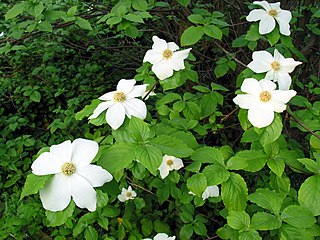
Cornus nuttallii, the Pacific dogwood,western dogwood, or mountain dogwood, is a species of dogwood tree native to western North America. The tree's name used by Hul'q'umi'num'-speaking nations is Kwi’txulhp.

The Fellhorn is a mountain in the "Allgäu Alps" near Oberstdorf, Germany, on the border with Austria. It is known for its fields of alpenroses. According to Austrian sources the mountain is 2,039 m above sea level (AA).
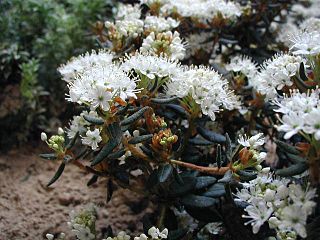
Rhododendron tomentosum, commonly known as marsh Labrador tea, northern Labrador tea or wild rosemary, is a flowering plant in the subsection Ledum of the large genus Rhododendron in the family Ericaceae.
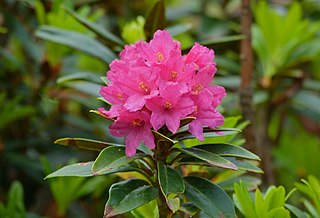
Rhododendron ferrugineum, the alpenrose, snow-rose, or rusty-leaved alpenrose is an evergreen shrub that grows just above the tree line in the Alps, Pyrenees, Jura and northern Apennines, on acid soils. It is the type species for the genus Rhododendron.

Draba aizoides is a species of flowering plant in the family Brassicaceae, known as yellow whitlow-grass. It is native to Europe where it is found on limestone rocks and walls. In the British Isles it is found only on the Gower Peninsula in Wales.

Rhododendron occidentale, the western azalea or California azalea, is one of two deciduous Rhododendron species native to western North America. The western azalea is known to occur as far north as Lincoln and Douglas Counties in Oregon and as far south as the mountains of San Diego county. Typically found in the coastal ranges of western North America, it also grows in the Cascade and Sierra Nevada mountain ranges, but is not known east of them.

Rhododendron calendulaceum, the flame azalea, is a species of Rhododendron endemic to the southern and central Appalachians of North America. All parts of this plant are poisonous to humans. Rhododendron calendulaceum is a popular cultivated plant due to its bright yellow, orange or red flowers.
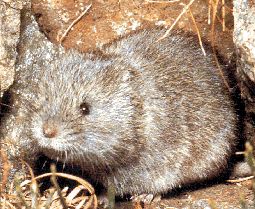
The European snow vole or snow vole is a species of rodent in the family Cricetidae. It has dense, pale grey fur and a pale-coloured tail and can reach about 14 cm (5.5 in) long, with a tail which is 7 cm (2.8 in) long.

Montane ecosystems are found on the slopes of mountains. The alpine climate in these regions strongly affects the ecosystem because temperatures fall as elevation increases, causing the ecosystem to stratify. This stratification is a crucial factor in shaping plant community, biodiversity, metabolic processes and ecosystem dynamics for montane ecosystems. Dense montane forests are common at moderate elevations, due to moderate temperatures and high rainfall. At higher elevations, the climate is harsher, with lower temperatures and higher winds, preventing the growth of trees and causing the plant community to transition to montane grasslands and shrublands or alpine tundra. Due to the unique climate conditions of montane ecosystems, they contain increased numbers of endemic species. Montane ecosystems also exhibit variation in ecosystem services, which include carbon storage and water supply.

Rhododendron aberconwayi (碟花杜鹃) is a species of flowering plant in the heath family Ericaceae, native to north-central Yunnan, China, where it grows at altitudes of 2,200–2,500 m (7,200–8,200 ft). This evergreen shrub grows to 1.5–2.5 m (4.9–8.2 ft) in height, with leathery leaves that are oblong-elliptic to broadly lanceolate, 2.5–5 by 1–1.8 cm in size. The flowers are predominantly white or pale pink, spotted purple.

Rhododendron fortunei is a rhododendron species native to China, where it grows at altitudes of 600–2,000 meters (2,000–6,600 ft).

Rhododendron lapponicum, the Lapland rosebay, is a dwarf rhododendron species found in subarctic regions of North America, Europe and Asia, where it grows at altitudes ranging from sea level to 1,900 m (6,200 ft). It is an evergreen prostrate shrub growing to 20–45 cm (7.9–17.7 in) in height, with leaves that are oblong-elliptic or ovate-elliptic to oblong-obovate, 0.4–1.5 by 0.2–0.5 cm in size. The flowers are reddish or purple.

The Zirbitzkogel, at 2,396 m (AA), is the highest point of the Seetal Alps in Austria. It lies south of the Upper Mur valley in the Styria near its border with Carinthia. The Lavant, a left tributary of the Drau, has its source on the southern slopes of the mountain.

Rhododendron veitchianum is a species of flowering plant in the heath family Ericaceae, native to Myanmar, Thailand, and Laos, where it grows at altitudes of 900–2,400 m (3,000–7,900 ft)

Rhododendron laetum is a rhododendron species native to the Anggi Lakes area of the Arfak Mountains in Indonesia and western New Guinea, where it grows at forest edges, in open marsh, and in swamps at the edge of lakes. This evergreen shrub grows to 3 m (9.8 ft) in height, with leaves that are broadly elliptic or sub-ovate-elliptic, 40–95 × 25–53 mm in size. The flowers are deep yellow, flushing with red or orange as they age.
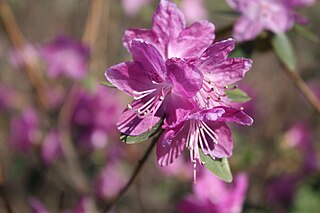
Rhododendron dauricum is a species of flowering plant in the heath family Ericaceae native to forests and forest margins in Eastern Siberia, Mongolia, North China and Hokkaido, Japan. The Latin specific epithet dauricum means "from Siberia" – Transbaikal is also known as Dauria.

Rhododendron falconeri, the falconer rhododendron, is a species of flowering plant in the family Ericaceae, native to the eastern Himalayas. It is a large evergreen shrub or tree, and sometimes the dominant canopy tree, that typically grows to 12–15 m (39–49 ft) in height, with leathery leaves that are elliptic to obovate in shape and usually about 1 ft (0.30 m) in length. Flowers are white to cream, pale yellow, or pinkish, with a prominent purple blotch.
